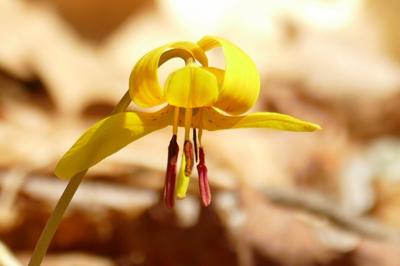You have been waiting in your dormant state until spring patiently — ever so patiently — for the time of lengthening days, warming soil and the moment when you can thrust your little sprout out of the rich earth. You do this before the deciduous trees above you leaf out so you have first dibs in the bright sunshine reaching the forest floor, where you thrive, especially along streams and brooks, rocky ledges, cliffs and mountain sides in forests dominated by sugar maple, ash and black cherry trees. You are a spring ephemeral.
Your timing is just right, because trees require great quantities of water to develop leaves each spring, so much so that they lower the water table. You can’t thrive in the calcium-rich soil where you have lain dormant all winter without the same water trees will soon devour. Spring ephemerals in the Berkshires emerge during a short window, only from snowmelt until leaves emerge.

These marvelous little wonders bloom, get pollinated and set seed all within a few weeks, most of them starting in May. That’s why they’re called “ephemerals,” from Greek “ephemeros,” meaning lasting only one day, short-lived. In Medieval Latin, “ephemera (febris)” referred to a fever lasting only a day, and in the 17th century the sense of “short-lived” applied to insects and flowers.
By the 18th century, “ephemera” meant anything transitory, its meaning today . Like all flora and fauna, including spring ephemerals, humans have a limited lifespan. Our closest cousins, chimpanzees (99 percent same DNA) and bonobos (98.
7 percent same DNA), in captivity live up to 60 years and 40 years respectively, shorter for each when living in the wild. Average life expectancy for someone born today is 79.1 years for women and 73.
2 years for men, but that’s not in the wild. The longest living mammal is the bowhead whale, one of several marine species that outlive humans. It can live even longer than 200 years.
The shortest? Weasels live only one or two years, but make up for it by having up to 13 kits in a litter and up to three litters a year. The animal with the shortest lifespan of all is the mayfly, which typically lives for only one day. What if you could live as long as Methuselah? According to the Bible (Genesis 5:27), he lived 969 years, but that is more likely a reference to 969 months, which is about 81 years.
If everyone living today lived forever, no future generations would be possible —after all, the Earth now supports 8 billion people. Would you deny those future generations all the precious moments in life you have already experienced? Probably not. Accordingly, we all must accept that, like spring ephemerals, our life spans are limited, and so we should make the most of the time we have.
You can admire these evanescent beauties this time of year by getting into the woods. Go to “ Spring Ephemerals: A Field Guide for Massachusetts ” at the mass.gov website for close-up photos of these reminders of your own mortality and for inspiration about how to devote your remaining lifespan.
.
Politics

Word of the Week: Ephemerals. These beauties are a reminder of our own fleeting existence

We all must accept that, like spring ephemerals, our lifespans are limited, and so we should make the most of the time we have.















